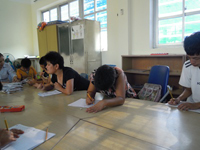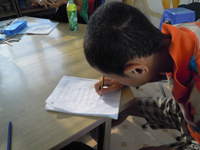活動報告
ベトナム・Vietnam Volunteers for Peace/今日のベ トナム―ベトナム戦争の経験とともに
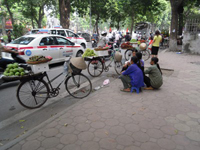 |
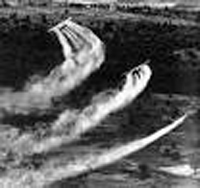 |
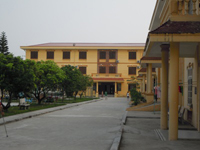 |
Fig.1 Vietnam |
Fig.2 Agent Orange |
Fig.3 Friendship Village |
|
|
|
Fig.4 Children in classroom |
Fig.5 A boy studying |
Chihiro Abe ![]()
Department of Applied Chemistry
Graduate School of Engineering
Host Organization: Vietnam Volunteers for Peace Vietnam
Location: COMA6, Duong 70, Tay Mo Tu Liem, Ha Noi-Vietnam
Duration: 03 / 09 / 2012 To 16 /10 /2012
1. Back ground
1) Objective
The Vietnam War (1960-1975) has caused destruction and pollution of the natural environment, various diseases, anguish and children with a birth defect related to a chemical weapon named Agent Orange. At the present day, forty years have passed since the end of the Vietnam War.
I have researched about chemical synthesis in my laboratory. Synthesized compounds are mostly useful, but from a different aspect, they infrequently cause destruction and pollution of the natural environment and some diseases. Organic solvent and materials are used in the process of synthesis too. Agent Orange is a type of organic materials useful for killing weeds, but from a different aspect, it causes environmental problems and some diseases. And I always think that researchers should prioritize interests in influences on nature and the usefulness for people over researches. Vietnam was damaged by Agent Orange, chemical compounds. So I wanted to research about Vietnam, a victim country in the field, to think about it and search the direction of my research in the future.
2) Vietnam (VN) Ref.1)
Vietnam is located in South East Asia. Vietnam covers an area of 330.363 sq. km making it about as big as Italy. Vietnam has a 3400-kilometre coastline and mountainous terrain covers 75 % of the country. There are two huge and fertile river deltas where most population live, the Red River in the North and the Mekong River in the south.
With population of 86,210,860 (July 2008 est.) it is the thirteenth most populous country in the world. There are fifty four ethnic groups and the largest one is Viet (or Kinh) with more than 86 %. Vietnam’s former capital was Hue and its current one is Hanoi.
(3)The Viet Nam War (The VN War)
The Vietnam War (1960-1975) was the warfare between South VN and North VN ostensibly. But it was actually the warfare between the US, and the Soviet Union and China. In other words, it was the strategic war between capitalism and communism.
~History of the War in Viet Nam~ Rf.1)2)3)
1840-1842 The Opium War
1882 Occupied by France
1940 The Japanese military came in VN.
1941 Ho Chi Minh organized Viet Minh - purportedly a coalition of all anti- Japanese and French Vietnamese groups.
1946 The warfare between The French military and Viet Minh (The Indochina War) was happened.
1954 The French military surrendered to The Vietnamese one.
1964 The US forces had bombed North Vietnam. (The US had dusted chemical weapon called Agent Orange over Vietnamese fields for about 10 years.)
1973 The cease-fire
The VN War (it’s called the American War by Vietnamese.) has some characteristic features. For example, they had a free press (All reporters can enter the fields of the war free.). Many chemical weapons called Agent Orange had been used by the US and it has caused disabled people in VN. Finally, 58,000 US soldiers lost their lives in the War, and VN lost three million victims.
4) Agent Orange (AO)
Agent Orange is a kind of herbicides and they were used as a weapon at the VN War. Most of people call them AO, but weapons the US had used included other types of herbicides called Purple, Pink, Green and White. Ref.4), 5) The US military dusted them over rice fields, other cultivated lands and forests in order to cut off VN’s food supply and eliminate potential hiding places.
When the VN War started, The US said that AO gives damage to the natural environment, but do not damage human, so the US soldiers touched it with their bare hands. But, as time advanced, the confidence of such information was questioned , because Vietnamese came to have deformed children, and they got illness after the weapon spread. Ref.7)
First, Federation of American Scientists brought up an issue of AO’s risk in 1964. Then Prof. Edsall (1966), Pfeiffer (1966), Mayer (1967), and Dubos (1967) pointed out the problems of AO. Ref.8)
In addition, K.D.Courtny (The United States National Institutes of Health, 1969) bore out the AO’s risk by experiments in mice, and Prof. Meselson (Harvard University, 1970), M.D. Phuong pointed out that Vietnamese children born from a person who had taken AO had a great incidence of getting illness. Ref.4) And these studies found that dioxins contained in AO caused these diseases. Ref.4) At last the US stopped using AO in 1970. In the end, total amount of defoliant used in the War was 760,000 L. Ref.4)
Thirty seven years after the VN War, there are a lot of people and children suffering from the affect of AO in VN (8 million people), the US and Korea. Now, a lot of studies have brought out that AO causes cancer, the liver damage, nerve damage, melanin pigmentation and so on. Ref.4) And there are some facilities for AO victims, for example Tu Du Hospital in Ho Chi Minh City, Vietnam Friendship Village in Hanoi, and others. Ref.6), 9)
2. Activities
1) Interviews
I had interviewed Vietnamese university students and Prof. Vien about present VN experiences following the VN War.
◆Prof. Dong Minh Vien
He belongs to Department of Soil Science, College of Agriculture & Applied Biology, Can Tho University, and has studied aerobic and anaerobic biodegradation of dioxins. He told me his view on present dioxin pollution in VN as listed below.
・High concentration of dioxins in soils were found in former military airbases of Da Nang, A Luoi, and Bien Hoa, which are located in the South and middle part of Vietnam. Many disabled people affected by dioxins were found in areas heavily sprayed with Agent Orange such as Cua Quang Tri.
・There are few studies about biodegradation of dioxins in VN.
・It is too expensive in general to clean up dioxins in Vietnamese polluted hotpots.
◆Can Tho University students and Academy of Journalism & Communication students.
They told me their view on present Vietnam as follows.
・The VN government needs to stay coordinated with the US in order to assist victims on the financial front.
・Most of Vietnamese people worry that their children born to have disease affected by dioxins.
・Disabled people in a rural cannot use the facilities in town.
<Discussions based on interviews>
I found that Vietnamese students have a lot of interests in the VN war, because some of them voluntarily told me detailed the War history and some places where facilities for victims are, Most of them were interested in volunteer work for the victims. And they said they want to study and help the victims in their future. I was impressed by their wills to lead their country. But, they took no notice of a lottery sales person with disabilities (Although I did not know whether they were affected by dioxins or not.) , whenever they were spoken to by them in town. I thought that I had to ask students ideas about it.
2) Activities in Vietnam Friendship Village
◆About Friendship Village Ref.10)
Friendship Village is a center for living, health, and education of children affected by dioxins from AO. Founded in 1992 by George Mizo, an American veteran who was interested in helping to compensate for the damage given to the Vietnamese people by the war, and to rebuild VN-US relations.
Friendship Village’s main mission is to provide a place to live, necessary medical care, and constant supervision to physically and mentally disabled children whose parents cannot care for them adequately due to the severity of their condition, poverty, or the parents’ own health-related problems.
Friendship Village complex is composed of two living quarters, two classroom buildings, a health center, and a few other buildings used by the staff for cooking and general administration. It also has an assortment of vegetable gardens.
Friendship Village is home to 130 residents, aged four to twenty six, who come from forty three provinces in Vietnam. The residents’ disabilities include autism, cerebral-palsy, Downs-syndrome, physical deformation, and severe mental disabilities.
The staff includes nurses, medical technicians, and therapists, as well as teachers and caregivers.
The Village operates on an annual budget of USD 300,000, half of which is provided by the Vietnamese government with the rest of international aid.
◆My activities in Friendship Village
・Teaching math to children.
・Cleaning the classroom with children.
・Teaching changing of clothes to children.
・Playing with children after class.
・Making the garden.
<Discussions based on activities>
Sometimes a teacher uses violence such as hitting children by a wood stick in order to teach them. At first I was opposed to her educational way. However with assisting her, I had realized that she earnestly thinks about educations for children, so that she gives supplemental studies for severely disabled children after the class. And she said that it was difficult for her to teach children of varied disabled levels.
From these experiences, I thought that Friendship Village managers have to increase teachers for children and add staff to educate the teachers an education of physically and mentally handicapped children in order to make a good environmental for educations of the children.
3. Conclusion and my future vision based on the internship experience
At first, I intended to interview Vietnamese in general about the VN War, however I was not able to do it, because VN government has controlled some political activities. I realized that I had to prepare for my investigations in consideration of differences of environment between VN and Japan.
There were a lot of foreign volunteer members including me in Friendship Village. We had tended to force our ideas and styles against Vietnamese staff. However I had learned that it was important for us to fit in and understand Vietnamese custom by my activities in Friendship Village.
Sometimes some tour members from foreign countries visit the classes for a brief time and give the children snack, candy and so on. When the members visited there, the children delighted in snack and candy. But after their staying, a lot of garbage had been left there, and the teachers had to clean the class room in their busy schedules. By my experiences, I learned that we have to consider really-required supports at an actual place.
I had been studying only bad effects to the Vietnamese people by some chemical products by some references before this internship. Though, I found that the children in Friendship Village have not care the bad effects, and study, play and live with their hearts and souls every day. By this experience, I found that it is important to consider how to make happiness than cover the bad effects by chemistry.
I have had love for the children by my activities, and I want to solve the environmental problems strongly. All of companies and universities have set a goal of solving the problems, for example, making environmentally preferable materials. But I think that they can never solve the problems without love for people, the world and so on. And I think that love for someone is created by relationships between people. So I want to make opportunities for company members to inter-act with others like this internship and make atmosphere for truly solving the problems in my future.
4. References
1) Volunteers For Peace Vietnam, 2009-2010, NATIONAL PROFILE VIETNAM, 28pp
2) ベトナムの歴史概説, http://homepage1.nifty.com/Cafe_Saigon/03a8.htm, 28/08/2012
3) NHKエンタープライズ, 2005, 映像の世紀第9集 ベトナムの衝撃, DVD, 74 min
4) 宮田秀明, 1998, よくわかるダイオキシン汚染, 合同出版, 222pp
5) 篠原亮太, 貴戸東, 1991, ダイオキシン入門, 日本環境衛生センター, 410pp
6) 轡田 隆史, 1986, ベトナム枯れ葉作戦の傷跡, すずさわ書店, 246pp
7) 中村梧郎, 2005, 母は枯葉剤を浴びた, 岩波書店, 255pp
8) 本谷勲, 1972, ベトナム枯葉作戦と科学者の責任, 生物科学, 「第23巻」, (第3号)
9) 坂田雅子, 2009, 花はどこへいった, DVD, 71 min
10) The Friendship Village, Friendship Village-Project description, 5pp
5. Acknowledgment
Thank you very much for your supports.
< Friendship Village >
Director Dang Vu Dung, Mrs. Ha, Mrs. Huyen (teacher), Mr. Long, Hoa, Binh, Giang, Ngoc, Ly, Nam, Hai, Hau, Duong, Sang, and Huong, Hung
< Peace House >
Mrs. Hong, Ms. Duong, Mr. Kien, Mr. Khiem, James, Valery, David, Ziyu, Sophie, and Marten
< Can Tho University >
Prof. Vien, Tuoi, Nhi, Dang, Nam, Lam, and Thuy
< Academy of Journalism & Communication >
Tuyet, and 15 other students
< ICYE JAPAN >
Ms. Tomoko Ukaji, Ms. Fukushi
< Tokyo University of Agriculture and Technology >
Prof. Ai Imai, Prof. Sachi Ninomiya-Lim, Prof. Hirokazu Ozaki, Prof. Kenichi Yoneda, Prof. Hayashidani, Prof. Tarao, Mrs. Kyoko Shii, Mrs. Mizuho Shimada, Mr. Moriyama, Ms.Kinh, Mrs. Tam, Ms. Mudan, Mr. Jigemude, Ms. Hasegawa, and Ms. Nagata
